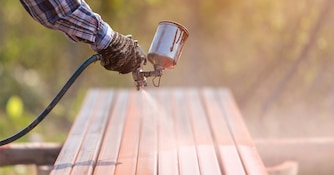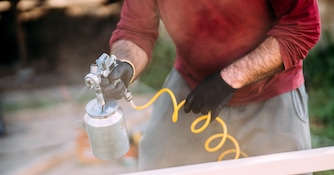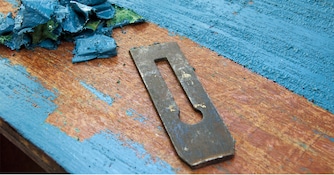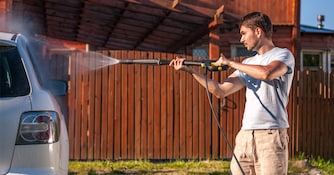
Using a Paint Sprayer Indoors
Whether you’re flipping a house or just want to give the walls inside your home a fresh look, interior paint sprayers can do the job faster, cleaner, and more efficiently than traditional brushes or paint rollers.
A paint sprayer allows you to cover large or small areas, tight corners, and harder-to-reach spaces easily without the worries of dripping paint from the ceiling, uneven lines, or hurting your back in the process.
In this article, we teach you how to use interior paint sprayers like the pros do and turn any indoor painting job into a satisfying project.
Choosing an Indoor Paint Sprayer
Whenever you use a paint sprayer indoors, it’s important to control how many paint particles are being sprayed into the air. To spray paint inside safely and accurately, you’ll want to use a paint gun that sprays paint without splattering it recklessly all over the room.
Each type of paint sprayer has specific uses, and choosing the right type for your project can get confusing. To keep things simple, the chart below explains the differences between HVLP and airless paint sprayers, and the applications they are best for.
| HVLP vs. Airless | HVLP Paint Sprayers | Airless Paint Sprayers |
|---|---|---|
 | 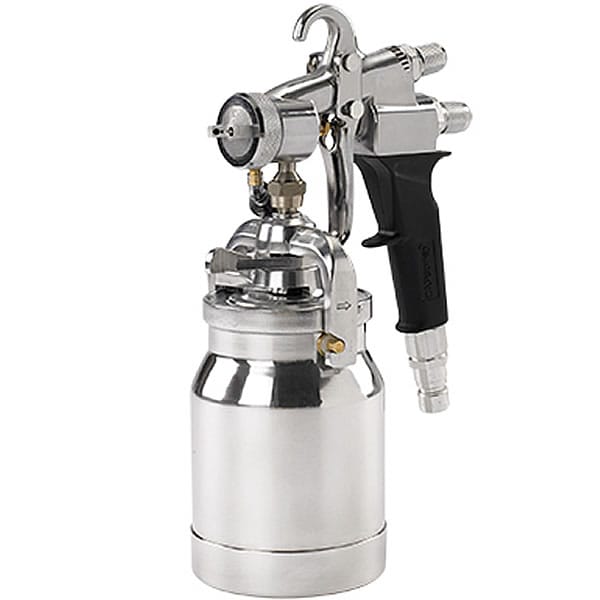 | 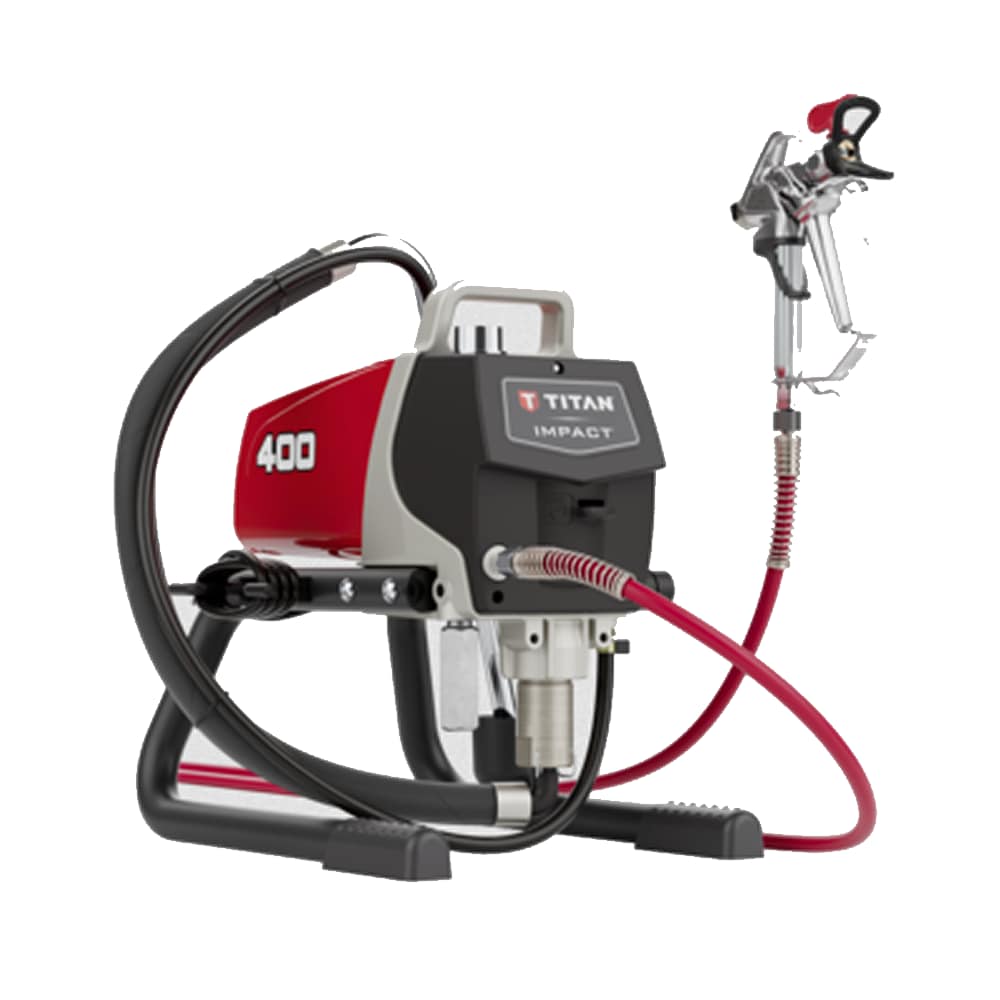 |
| Applications: | Fine, smooth finishes & detail work (smaller droplets) | Larger areas that don't need as much detail work (larger droplets) |
| Best Uses: | Painting or staining interior walls, doors, cabinetry, and trim | Painting or staining siding, fences, decks, and railing |
| Volume/Pressure: | High volume, low pressure - minimal overspray | High volume, high pressure - more overspray |
| Atomization: | Air and paint meet and atomize outside the tip | Atomized at the spray tip; can handle thicker material |
| Delivery: | Uses a turbine or air compressor and hose | No air compressor or turbine; pressurizes the material |
| Can store paint? | Yes, paint is stored in a separate, sealable, interchangeable container | No, must wash out hose, pump, and lines after using |
![]() LEARN MORE: HVLP Buyer's Guide
LEARN MORE: HVLP Buyer's Guide
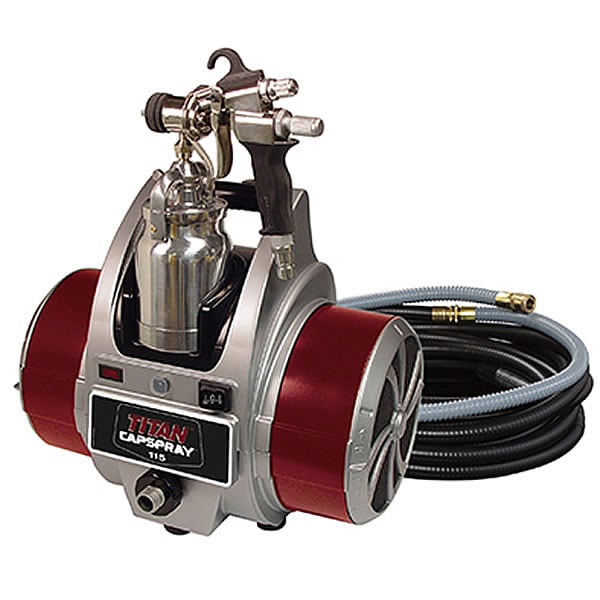
HVLP paint sprayers (High-Volume, Low-Pressure) were created to spray paint quickly and evenly without the excessive overspray that causes droplets and uneven coatings on painted surfaces.
HVLP sprayers are the best choice for interior paint spraying because they have the proper power and precision to quickly cover surfaces smoothly and evenly without much effort on your part. This is because HVLP paint sprayers can apply thinner, more even coats with minimal overspray.
For most HVLP applications, you won’t need to thin the paint you use, and because the paint canisters are separate from your line, unused paint can be stored, and you don’t need to worry about cleaning out the line before and after every use. However, HVLP guns are less effective at spraying thick coatings, so some thinning may be necessary for optimum results.
Best Indoor HVLP Applications for Fine Finishes
For fine-finish painting, HVLP paint sprayers include are the best choice for the following indoor applications:
- Interior Walls
- Cabinetry
- Doors
- Trimwork

Airless paint sprayers are best used when you need to cover large surface areas at high volumes when fine detail doesn't matter as much. They apply thick, heavy coats quickly but at the cost of increased overspray and larger droplets during application. If not used carefully, they can quickly fill the air with paint particles and splatter paint unevenly on your walls.
Because these guns operate at a much higher pressure, they can often use thicker paint straight from a can without filtering or reducing the paint first. However, you do not have control over the pressure, meaning they are meant to spray at full power at all times.
For these reasons, airless paint sprayers are not ideal for interior paint spraying applications and are better used outdoors for siding, decks, fences, and other larger projects.
Best Airless Paint Applications for Large Projects
For large-area exterior painting, the best outdoor applications for airless paint sprayers include:
- Siding
- Fences
- Decks
- Railings
How to Prep a Room for Painting
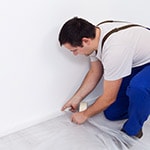
Like any painting project, the same general recommendations apply when using paint sprayers:
- Remove all non-paintable items like furniture from the room (or cover in drop-cloths)
- Remove (or mask) floor and window trim boards if you want to paint them separately
- Use a drop sheet (or even better, craft paper) to cover the floor completely and tape edges to hold in place
- Use plastic sheeting to seal off other parts of the house not being painted
- Tape off any light switches, electrical outlets, smoke detectors, and light fixtures
- Cover doors, door trim, and knobs
- For ceiling fans, cut open large garbage bags and tape off on the ceiling
- Open all windows in the room (and remove screens to prevent discoloring)
- Use a *cheap box fan in one window to draw paint particles outside
*The box fan may be coated in a thin layer of paint by the end, so use with discretion. You can also affix an HVAC filter on the fan to catch the particles.
What to Wear When Painting
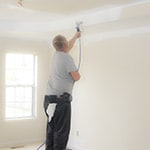
Though HVLP paint sprayers produce less overspray than airless sprayers, atomized paint can travel, and could possibly get into your nose and eyes. Protect yourself by wearing proper protection before painting. We recommend:
- Respiratory face mask
- Safety goggles/glasses
- Old clothing that can be sprayed with paint
- Old shoes that can be sprayed
- Old hat to protect your head from paint in the air
- Disposable gloves are also recommended
How to Spray Paint Indoors
Because each paint sprayer operates differently, consult the user manual before using your spray gun. The manual provides critical information about your specific paint sprayer to ensure you’re using it safely and effectively.
Use the directions to properly fill your HVLP sprayer with paint. Then, set the HVLP gun to the recommended settings for the type of paint you’re using. To fine-tune the settings, use a piece of plywood or drywall to practice your spray pattern and distance (6-8 inches is a great starting distance).
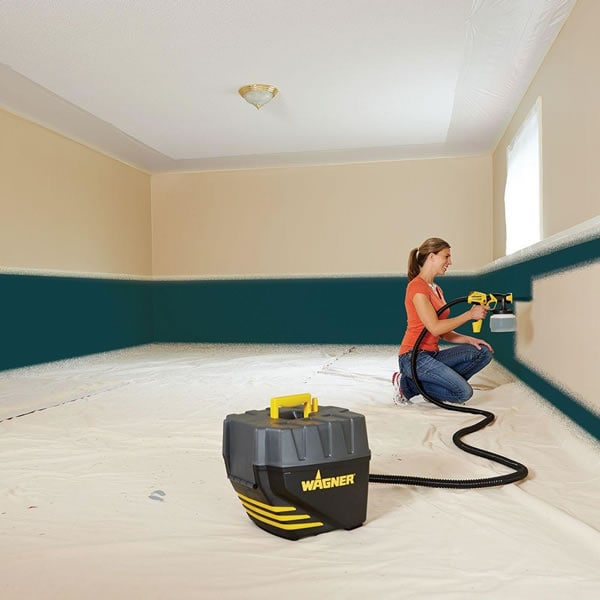
A spray gun tip usually has two orientations for spraying: horizontal and vertical. For side-to-side painting, the tip should be set to a vertical position, and for up-and-down patterns, the tip should be set horizontally.
An HVLP spray gun also has settings for pressure and width of the spray as well, so don’t be afraid to fine-tune the settings for optimal results on different applications.
Once you’ve practiced and achieved the optimal distance and coverage of paint, consistently keep the same distance from the surface you’re painting the whole time. Move parallel with the wall and avoid swinging your arm when you paint.
Don’t move the sprayer before the paint begins covering the wall, and stop moving before releasing the trigger on the gun to avoid streaking. It’s equally important to move at a consistent speed to evenly distribute the paint on the wall.
It's normally recommended to paint the ceiling first using a horizontal arm motion and vertical spray pattern. Once the ceiling is painted and dry, make sure to mask it off and cover it before painting the walls. This will ensure your lines are straight and clean, and you won't have to touch up the ceiling later on.
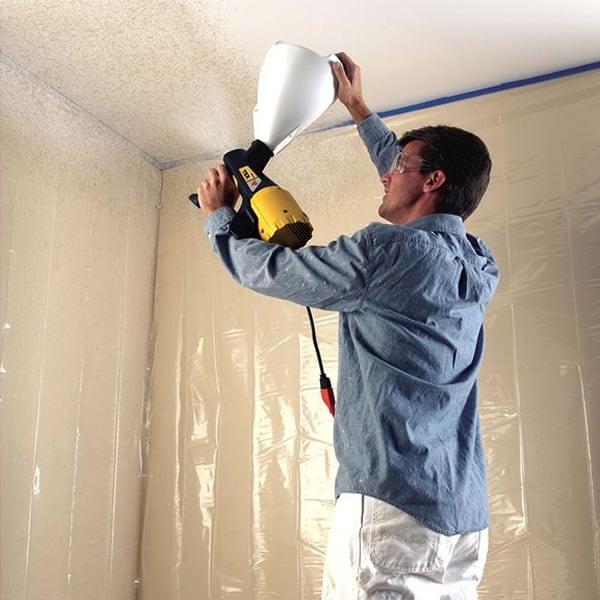
To paint interior walls, it’s recommended to paint a single wall at a time, starting with the ceiling, corners, and floor. Outline the perimeter of the wall first. Then, fill in the rest of the wall using a vertical arm motion with the tip set to a horizontal spray pattern.
For best results and full coverage, use a cross-hatch pattern for each coat by alternating horizontal and vertical passes with at least two coats of paint per surface. Overlap each pass by between 1/3 or 1/2 the width of the spray. It's the same concept as overlapping your passes while mowing the lawn. When the room is complete, wait about an hour before removing any coverings.
The Paint Sprayer Advantage
Deciding to use a paint sprayer for interior walls is one of the best decisions you'll make for your renovation projects. Not only do they make your job easier and much faster, but spray painting inside can turn a boring afternoon into a fun project. Before you know it, you'll have so much fun you'll be painting the whole house!


